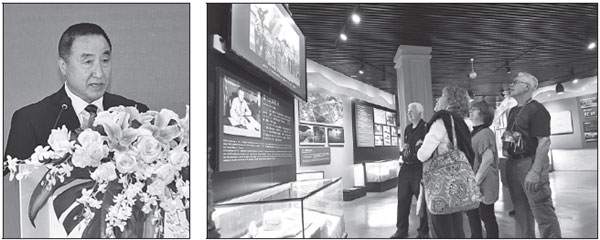On a mission to preserve the habitats of Flying Tigers
When Ma Kuanchi was a tour guide with the China International Travel Agency in the 1980s, he accompanied many American veteran pilots to Yunnan province and Guangxi Zhuang autonomous region - places where they had once been based during World War II.
On those trips, Ma learned the history of the Flying Tigers.
It was before the Japanese attack on Pearl Harbor in December 1941, and the United States hadn't officially entered the war, but around 300 American pilots and ground crew had already come to Southwest China to fight against the Japanese air forces under the command of Claire Lee Chennault.
They were officially known as the first American Volunteer Group, or AVG, but after their first combat mission, where they were victorious despite being heavily outnumbered, the Chinese referred to the pilots as the Flying Tigers.
The noses of the P-40 fighter planes they flew were painted with a ferocious shark mouth design, mimicking those flying missions in North Africa, and when the group was later absorbed into US Fourteenth Air Force, the planes retained the fearsome design. Equally, people continued to apply the legendary moniker of the Flying Tigers to later units, including the bomber and transport squadrons, that fought the Japanese in the sky.
"I was touched by their heroic deeds, and then decided to learn more of their history," Ma says, adding that he visited almost all of the old air bases used by the Flying Tigers in China.
However, when Ma talked to ordinary Americans, he found out that despite the Flying Tigers' contribution to the victory of the Allies, their story was not that well known in the US.
He organized themed aviation tours in early 2000 with his American friend Larry Jobe, a retired pilot with United Airlines, and the tour features visiting some of the Flying Tigers' heritage airfields.
James T. Whitehead, a retired US Air Force major general, was in one of the tour groups.
Whitehead says: "Most people didn't even know there was a war in China at that time. They knew about Normandy, North Africa and the battles with Germany and Italy, but not many people knew about the Flying Tigers except people associated with the military."
When the tour visited an old airfield in Guilin, Guangxi, they stood on rock in front of a cave that once served as Chennault's operation command.
"Standing on the rock, we could see the exact same scene as 1945. There were bomb craters, stone rollers and runways still there with weeds growing up through the cracks - very moving," Jobe recalls.
However, further down the valley, there was commercial and industrial development happening not far from the site.
"I said to Whitehead that it was good that he came when he did, because by the following year the scene would probably be gone forever," says Jobe. "And he said that if we don't do something to save it, the history that goes with it will also be gone."
The three later founded Flying Tigers Historical Organization, a nonprofit dedicated to preserving the shared history, sacrifices and heroics of the American and Chinese people during World War II.
"We felt that it was a story that needs to be told," Whitehead says. "There was a special relationship between the Americans and Chinese and it's important to remember that today."
The three founded the historical organization, worked with different government departments in China, collected memorabilia from the veterans and raised the funds for the construction of the Flying Tiger Heritage Park, which preserves the site of Yangtang airfield in Guilin.
Opened in 2015, the park includes a museum, aircraft shelters and relics of the command post located in the cave.
The organization has collected and donated around 4,000 exhibits to the park so far, says Ma.
In 2016, the organization donated a Douglas C-47 Skytrain, a type of transport plane used by the Flying Tigers during the war, and conducted a re-enactment of the wartime route with the old plane.
During the war, transporting military supplies to China involved flying across the Himalayas, a deadly route that claimed lives of many American pilots.
Jobe was on the plane during the re-enactment flight, with four other pilots.
"We didn't fly the 'Hump route' under the adverse conditions that they did in World War II. We didn't have any fighters shooting at us. We had much better weather reporting and GPS for navigation. We had everything going for us and nothing going against us," he says.
The flight was nevertheless dangerous. Having taken off from Australia on Aug 16, 2016, the old plane's engine failed twice during the flight, and an original eight-day trip was prolonged to three months. On Nov 19 that year, the plane finally landed in Guilin.
"Through the re-enactment, we wanted to shine a light on the history and bring that forward a little bit more, and we wanted a plane in the museum," he says.
|
Left: Ma Kuanchi, co-founder of the Flying Tigers Historical Organization, gives a speech at a seminar on the heritage of US Flying Tigers held in Guilin, Guangxi Zhuang autonomous region, on April 25. Provided to China Daily Right: Larry Jobe (left), president of the Flying Tigers Historical Organization, revisits the Flying Tiger Heritage Park in Guilin on March 30 with the families and relatives of former Flying Tiger pilots. Li Huichao / For China Daily |
(China Daily Global 06/07/2019 page11)



















